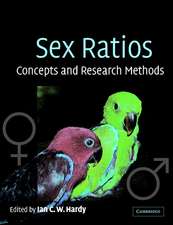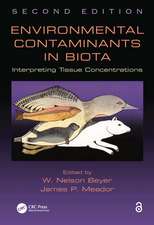Chemical Communication in Crustaceans
Editat de Thomas Breithaupt, Martin Thielen Limba Engleză Paperback – 20 aug 2014
Significant advances have been made in our understanding of crustacean chemical communication during the past decade. This includes knowledge about the identity, production, transfer, reception and behavioral function of chemical signals in selected crustacean groups. While it is well known that chemical communication is an integral part of the behavioral ecology of most living organisms, the intricate ways in which organisms allocate chemicals in communication remains enigmatic. How does the environment influence the evolution of chemical communication? What are the environmental cues that induce production or release of chemicals? How do individuals economize production and utilization of chemicals? What is the importance of molecule specificity or mix of a molecule cocktail in chemical communication? What is the role of chemical cues in multimodal communication? How does the ontogenetic stage, the sex or the physiological status of an individual affect its reaction to chemical cues? Many of these questions still represent important challenges to biologists.
| Toate formatele și edițiile | Preț | Express |
|---|---|---|
| Paperback (1) | 1794.84 lei 6-8 săpt. | |
| Springer – 20 aug 2014 | 1794.84 lei 6-8 săpt. | |
| Hardback (1) | 1799.92 lei 6-8 săpt. | |
| Springer – 25 noi 2010 | 1799.92 lei 6-8 săpt. |
Preț: 1794.84 lei
Preț vechi: 2188.83 lei
-18% Nou
Puncte Express: 2692
Preț estimativ în valută:
343.56€ • 360.65$ • 283.80£
343.56€ • 360.65$ • 283.80£
Carte tipărită la comandă
Livrare economică 30 ianuarie-13 februarie 25
Preluare comenzi: 021 569.72.76
Specificații
ISBN-13: 9781489981493
ISBN-10: 1489981497
Pagini: 584
Ilustrații: XVIII, 565 p.
Dimensiuni: 155 x 235 x 31 mm
Greutate: 0.88 kg
Ediția:2011
Editura: Springer
Colecția Springer
Locul publicării:New York, NY, United States
ISBN-10: 1489981497
Pagini: 584
Ilustrații: XVIII, 565 p.
Dimensiuni: 155 x 235 x 31 mm
Greutate: 0.88 kg
Ediția:2011
Editura: Springer
Colecția Springer
Locul publicării:New York, NY, United States
Public țintă
ResearchCuprins
PART I. INTRODUCTORY SECTION1. M. Thiel & T. Breithaupt: Chemical Communication in Crustaceans: research challenges for the 21st century 2. T. D. Wyatt: Pheromones and behaviorPART II. GENERAL OVERVIEW OF SIGNAL CHARACTERISTICS AND RECEPTION3. M. E. Hay: Crustaceans as powerful models in aquatic chemical ecology4. M. J. Weissburg: Waterborne chemical communication: stimulus dispersal dynamics and orientation strategies in crustaceans5. M. A. R. Koehl: Hydrodynamics of sniffing by crustaceans 6. E. Hallberg & M. Skog: Chemosensory sensilla in crustaceans7. M. Schmidt & D. Mellon: Neuronal processing of chemical information in crustaceans8. B. S. Hansson, S. Harzsch, M. Knaden and M. Stensmyr: The neural and behavioral basis of chemical communication in terrestrial crustaceansPART III. CHEMICAL COMMUNICATION AND BEHAVIOR9. J. Yen & Lasley: Chemical communication between copepods: finding the mate in a fluid environment10. M. Thiel: Chemical communication in peracarid crustaceans11. K. Mead & R. Caldwell: Mantis Shrimps: olfactory apparatus and chemosensory behavior12. J. Aggio & C. D. Derby: Chemical communication in lobsters13. T. Breithaupt: Chemical communication in crayfish14. R.T. Bauer: Chemical communication in decapod shrimps: the influence of mating and social systems on the relative importance of olfactory and contact pheromones15. F. Gherardi & E. Tricarico: Chemical ecology and social behavior of Anomura16. J. H. Christy & D. Rittschoff: Deception in visual and chemical communication in crustaceans17. E. A. Hebets & A. Rundus: Chemical communication in a multimodal context 18. B. A. Hazlett: Chemical cues and reducing the risk of predationPART IV. TOWARDS IDENTIFICATION OF CHEMICAL SIGNALS19. J. Hardege & J. Terschak: Identification of crustacean sex pheromones20. M. Kamio & C. D. Derby: Approaches to a molecular identification of sex pheromones in blue crabs21. E. S. Chang: The crustacean endocrine system and pleiotropic chemical messengers22. A.S. Clare: Towards a characterization of the chemical cue to barnacle gregariousness23. T. Snell: Contact chemoreception and its role in zooplankton mate recognition24. Y. W. Chung-Davidson, M. Huertas & W. Li: A review of research in fish pheromonesPART V. APPLIED ASPECTS:25. A. Barki, C. Jones & I. Karplus.: Chemical communication and aquaculture of decapod crustaceans: needs, problems and possible solutions 26. K. H. Olsén: Effects of pollutants on olfactory mediated behaviors in fish and crustaceans27. T. C. Baker: Insect pheromones: useful lessons for crustacean pheromone programs?
Recenzii
From the reviews:
“This well-edited, multiauthored book reviews how crustaceans––mainly aquatic––orients to and communicates via chemical signals and cues and thus helps us understand the ocean’s cryptic life. … This volume will be of concern to anyone working with the chemical ecology of aquatic organisms as it represents steps toward deciphering the perceptive world of aquatic organisms and identifies future research avenues.” (Thomas Kiørboe, The Quarterly Review of Biology, Vol. 87 (2), June, 2012)
“This well-edited, multiauthored book reviews how crustaceans––mainly aquatic––orients to and communicates via chemical signals and cues and thus helps us understand the ocean’s cryptic life. … This volume will be of concern to anyone working with the chemical ecology of aquatic organisms as it represents steps toward deciphering the perceptive world of aquatic organisms and identifies future research avenues.” (Thomas Kiørboe, The Quarterly Review of Biology, Vol. 87 (2), June, 2012)
Textul de pe ultima copertă
Crustaceans are ecologically and economically important. They are fished and farmed extensively for food and are model organisms for scientific research. However, as invasive species, some crustaceans also threaten native communities world-wide. Social interactions of these primarily aquatic invertebrates are generally mediated through chemicals. Hence, the study of chemical communication by crustaceans is fundamental to understanding their biology and developing strategies to manage and protect them. Research in this area also promises discoveries of new waterborne natural products. This book provides the first comprehensive synthesis of current knowledge on crustacean chemical communication. Leading experts review different aspects of chemical communication and share their fascination with their research with the reader. Opening with an overview of the challenges and concepts of crustacean chemical communication research, the book proceeds to explore signal transmission and reception, and neural processing. The behavioral context of chemical communication is reviewed for the best-studied species. Recent advances in the molecular identification of crustacean chemical signals are presented, followed by discussions of their possible applications in aquaculture and management. Additional chapters provide complementary knowledge from other taxa (fish, insects) and topics (multimodal communication, deception, ecotoxicology), highlighting opportunities for future research. The book is richly illustrated and avoids technical jargon, making it accessible to a broad readership including researchers and students of ecology, evolution, behavior, and neurobiology, as well as non-scientists interested in fisheries, aquaculture, and environmental management. “This excellent and comprehensive volume fills a major gap in the field of chemical ecology and behavioral physiology. The editors assembled an outstanding group of expert contributors.”- Bert Hölldobler, Arizona State University and University of Würzburg“The topics are timely, the reviews current and the approach refreshingly synthetic. I see this book being useful for many years to come to the entire community of aquatic chemical ecologists.”- Peter W. Sorensen, University of Minnesota “The chapters are lucidly written by the outstanding experts in their fields. The book is a must-read for all those interested in the underwater world.”- Jelle Atema, Boston University and Woods Hole Oceanographic InstitutionABOUT THE EDITORSThomas Breithaupt is a lecturer in the Department of Biological Sciences at the University of Hull (UK) where he studies the mechanisms and evolution of chemical communication and orientation in crustaceans and fish.Martin Thiel is professor of Marine Biology at Universidad Católica del Norte in Coquimbo (Chile) where together with his students he uses crustaceans as model organisms to study the evolution of social behavior in the sea.
Caracteristici
This book covers a wide range of topics, including the identity, production, transmission, reception and behavioral function of chemical signals in selected crustacean groups.
Chemical signaling is the most widespread form of communication in crustaceans.
During the past two decades there have been significant advances in our understanding of crustacean chemical ecology.
Includes supplementary material: sn.pub/extras
Chemical signaling is the most widespread form of communication in crustaceans.
During the past two decades there have been significant advances in our understanding of crustacean chemical ecology.
Includes supplementary material: sn.pub/extras














